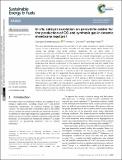In situ catalyst exsolution on perovskite oxides for the production of CO and synthesis gas in ceramic membrane reactors
Author(s)
Dimitrakopoulos, Georgios Theodoros; Ghoniem, Ahmed F; Yildiz, Bilge
DownloadPublished version (690.5Kb)
Publisher with Creative Commons License
Publisher with Creative Commons License
Creative Commons Attribution
Terms of use
Metadata
Show full item recordAbstract
This work demonstrates and assesses the concept of in situ catalyst exsolution in ceramic membrane reactors for the co-production of carbon monoxide (CO) and syngas through carbon dioxide (CO[subscript 2]) splitting and methane (CH[subscript 4]) partial oxidation, respectively. We use dense pellets of La[subscript 0.85]Ca[subscript 0.10]Fe[subscript 0.95]Ni[0.05]O[subscript 3-δ] (LCFN) as a model membrane reactor system. By combining in situ reaction rate measurements under finite oxygen (O[subscript 2]) flux and ex situ material characterization, we show that exsolution of nickel (Ni[subscript 0]) metal nanoparticles takes place in situ on both sides of the LCFN membrane under sufficiently reducing conditions controlled by the presence of CH[subscript 4]. To understand the impact of temperature and inlet fuel concentration on the nucleation, performance and long-term stability of the catalytic particles, exsolution of Ni[subscript 0] from LCFN was investigated at 900 °C, 950 °C and 1000 °C and with different concentrations of CH[subscript 4]. Nickel particles with sizes ranging between 100 nm and 300 nm formed on LCFN pellets at 950 °C and 1000 °C using CH[subscript 4] as the in situ reducing agent at a threshold inlet CH[subscript 4] mole fraction of 16% and 4%, respectively. Nickel exsolution was not observed at 900 °C. No pre-reduction of the sample in a hydrogen (H[subscript 2]) environment was required. As a result, significant performance increase was obtained. Exsolution on LCFN samples at different temperatures results in almost identical performance when compared under similar conditions. Reaction rates obtained after nickel exsolution were stable over long durations, suggesting that the grown particles are resistant to agglomeration in the hydrocarbon environment. Results shown in this work demonstrate that in situ, on demand catalyst exsolution by using the feedstock fuel can be an effective way of improving the surface kinetics of perovskite oxides for ceramic membranes.
Date issued
2019-06Department
Massachusetts Institute of Technology. Department of Nuclear Science and Engineering; Massachusetts Institute of Technology. Department of Mechanical Engineering; Massachusetts Institute of Technology. Department of Materials Science and EngineeringJournal
Sustainable Energy & Fuels
Publisher
Royal Society of Chemistry (RSC)
Citation
Dimitrakopoulos, Georgios. "In situ catalyst exsolution on perovskite oxides for the production of CO and synthesis gas in ceramic membrane reactors." Sustainable Energy & Fuels 9, 3 (June, 2019): 2347. © 2019 The Royal Society of Chemistry.
Version: Final published version
ISSN
2398-4902